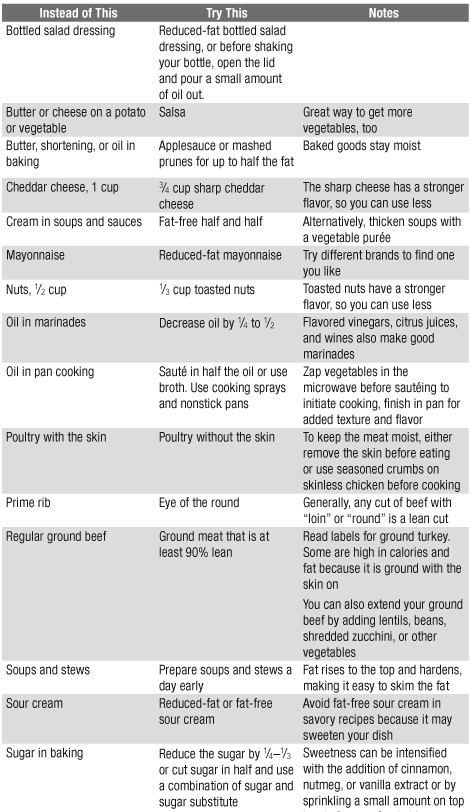
So far, we have covered quite a bit about food choices and exercise, and you have probably made great strides in both areas. Though we touch on physical activity again, this week we discuss two new topics that are important for continued success: the way you may talk to yourself when you’ve strayed from your diet and weight-friendly techniques for preparing foods at home.
Do any of these sound familiar? Too busy. Too tired. Too hot. Too cold. Too windy. Instead of finding excuses not to exercise (and we all have them), start looking for excuses to exercise. What are the tangible benefits that you experience when you are physically active? There are health benefits, such as lower blood pressure and improved cholesterol, and there are benefits to the way you feel. Blow off a bad mood with a yoga class or look forward to a sounder sleep with a bike ride earlier in the day. Now is a good time to consider this. Make a written list and put it in your Motivation Kit.
Physical activity is more than structured exercise. Try to increase your activity through both planned exercise and regular daily activities. Think about your day and all of the things that need to get done. Maybe the tasks that could get you moving you instead delegate to others. What chore can you tackle while getting some physical activity? Vacuuming the family room burns more calories than sitting in the family room watching television. Even letting the dogs in and out adds enough steps over several months to make a difference. Instead of asking someone else to tend to the barking, feel good about doing it yourself. This is a different way to look at your day. Practice it enough, and being active will become second nature. Here are some other options for adding physical activity to your day.
• Beat stress with a 10-minute walk instead of watching TV or reading a magazine.
• Walk next door instead of picking up the phone. Walk to your coworker’s desk instead of calling or emailing.
• Walk or bike with a friend instead of meeting for lunch.
• Pace around the house while on the phone or while waiting for a pot of water to boil.
• Mop or vacuum.
• Wash and vacuum the car.
• Play with the kids.
• Play active video games.
• Do sit-ups, push-ups, or knee-bends or jump rope during commercial breaks.
If you stray from your diet plan or slack off on some goals, you can either beat yourself up or pick yourself up. Which will lead you to your goal? A lot of people are pretty darn hard on themselves after a dietary indiscretion or a few days without exercise. Beating yourself up doesn’t help. Really and truly, it doesn’t! Perhaps disappointment or a tiny bit of guilt is beneficial if it spurs you on to do better, but a lot of guilt simply holds us back.
Stop to think about how you talk to yourself when you’ve strayed from your diet plan. The following scenario is all too common.
In this scenario, the feelings of self-loathing and self-doubt led the dieter further astray. It became a self-fulfilling prophecy. Speaking negatively and making the problem seem unfixable and bigger than it really is kept this person from taking positive action. Let’s reverse this trend and see how positive self-talk can be beneficial when you hit a roadblock.
It’s easy to see that the second pattern of thinking is far more productive. It’s hard work, however, to change a pattern of thinking that you’ve been following for most of your life. But once you are there, you will see how liberating it is to be rid of the negativity. So, how can you change your way of thinking? The first step is to pay attention to the words you say to yourself. Once you notice the negative self-talk, step back and observe the situation objectively—like you would if you were watching someone else. Would you be as harsh? Does eating two pieces of cake really mean failure? To help you put it into perspective, ask yourself if this will really matter in three months. If you treat it as the simple mistake it is and move on, then the answer is no, it will not make a difference in three months or even three days. Once you see the situation objectively, the next step is to make a plan to handle a similar situation better next time. Be realistic, though. We all falter, and there will be a next time. Slipping up on your diet doesn’t mean you are a failure any more than having a fender bender means you are a dangerous driver.
When you cook your meals at home, you have so much flexibility in what you eat and how it’s prepared. At home, you can easily measure your food to estimate the carbohydrates and calories. You can control the sodium and limit the saturated fats. You can pile on the vegetables and eat the combinations of foods you most enjoy.
Traditional recipes tend to load up on calories by using more fat than necessary. Be at least a little stingy with all fat because it’s highly caloric. Also, limit trans fats and saturated fats for the sake of your heart (more about that in Month 6). Find ways to use less or choose a different cooking method. For example, deep frying uses more oil than roasting or sautéing. Often a recipe will call for browning meat in several tablespoons of oil, when really just one tablespoon will do. Try these healthy cooking strategies.
• Flavor food with fancy vinegars and fresh or dried herbs instead of extra fat and salt.
• Cook with nonstick pans.
• Spray small amounts of oil into the pan or directly on the food.
• Use small amounts of broth, flavored vinegar, or even water to deglaze your pan (scrape up bits of meat or vegetables stuck to the bottom of the pan) instead of using extra oil.
• Add complexity to your recipe by browning meats before baking or stewing.
• Use smart cooking techniques: baking, braising, poaching, roasting, sautéing, steaming, and stir-frying.
5 Cool Tools for the Smart Cook
Use these to pump up flavor, whittle away at extra fat and salt, and boost nutrition.
1. Gravy separator: Use the flavorful liquid at the bottom of the cup to make your gravy. The high-calorie, high-saturated-fat portion rises to the top. If you do not have a gravy separator, you can do it yourself. Allow the gravy to cool. The fat will rise, allowing you to skim off the fatty portion of the gravy.
2. Zester: Grate citrus zest over plain brown rice or green vegetables. Grate just a smidgeon of Parmesan cheese over your salad or dark chocolate over fresh fruit.
3. Herb scissors: Make easy work of snipping herbs, which are natural flavor boosters.
4. Oil pump mister: Spray your favorite oil into the pan or right onto your food.
5. Immersion blender: Purée small amounts of vegetables, such as potatoes and cauliflower, to thicken sauces and other dishes. Purée carrots, winter squash, or tomatoes right in the cooking pot to make thick, velvety soups without the cream. Use this technique when you prepare Curry Roasted Cauliflower Soup (available in the Appendix).
 As an electrician on a university campus, I I have to provide services to all of the buildings. I used to ride in a truck instead of walking. Now when I don’t need the truck for a large load of materials, I walk all over the campus to get in more steps and burn more calories. I even walk up and down some of the handicap ramps when entering or leaving the buildings to get as many steps as I can. The university has a fitness center too, so I use their treadmill and weight equipment at least three times a week. With all of this exercise and a better diet, my glucose is in the normal range and I lost 60 pounds!
As an electrician on a university campus, I I have to provide services to all of the buildings. I used to ride in a truck instead of walking. Now when I don’t need the truck for a large load of materials, I walk all over the campus to get in more steps and burn more calories. I even walk up and down some of the handicap ramps when entering or leaving the buildings to get as many steps as I can. The university has a fitness center too, so I use their treadmill and weight equipment at least three times a week. With all of this exercise and a better diet, my glucose is in the normal range and I lost 60 pounds! Food slip-ups are not a big deal in the grand scheme of things. Slip-ups happen often, and realizing it’s not a big deal helps me move past it. To keep the slip-up from becoming a total diet fiasco, I think about my two alternatives: a) continue back into old habits that were clearly a problem for me or b) try harder and get back to the basic strategies that bring me success. The solution for me is to muster up self-initiative and motivation by thinking of all the work I’ve done to get where I am and asking myself if I really want to throw it all away. This is where I reset and use my initial strategies for success to get back on track and to move forward. After all, I’ve already figured out how to do it and can use that as my tool to find my way back.
Food slip-ups are not a big deal in the grand scheme of things. Slip-ups happen often, and realizing it’s not a big deal helps me move past it. To keep the slip-up from becoming a total diet fiasco, I think about my two alternatives: a) continue back into old habits that were clearly a problem for me or b) try harder and get back to the basic strategies that bring me success. The solution for me is to muster up self-initiative and motivation by thinking of all the work I’ve done to get where I am and asking myself if I really want to throw it all away. This is where I reset and use my initial strategies for success to get back on track and to move forward. After all, I’ve already figured out how to do it and can use that as my tool to find my way back.
 Continue the following goals: _________________________________________________________
Continue the following goals: _________________________________________________________